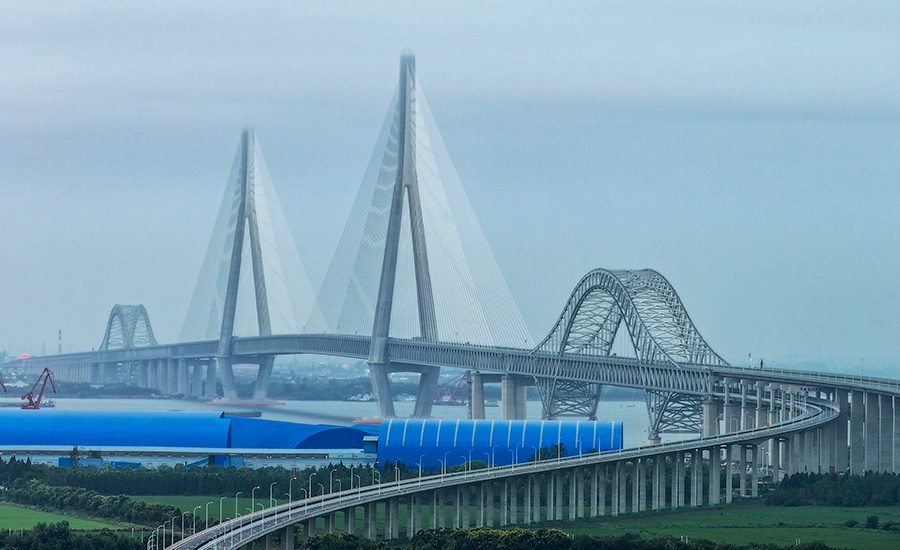World’s Longest Cable-stayed Bridge Opens in China

China’s recently inaugurated Chantai Yangtze River Bridge, whose 1,208-m-long main span secures it the title of the world’s longest cable-stayed bridge, came with its share of engineering challenges.
“It has set three world records: the largest span cable-stayed bridge, the most significant span highway and railway dual-purpose steel truss arch bridge, and the largest continuous-length steel truss bridge,” contractor China Railway Group Ltd. said in a statement.
Explaining the size of the 10.3 km long bridge over the wide Yangtze River, Chinese media compares it to building a bridge over the Mississippi River. The bridge, which opened to the public on September 11, reduces the travel time between the cities of Changzhou and Taizhou from one hour to 20 minutes.
Record bridges over the Yangtze have been a major part of China’s infrastructure buildout in recent decades. Six of the ten longest cable-stayed bridges in the world are over the Yangtze and were built in the last 20 years.
Unusual Asymmetrical Design
The bridge’s lower deck features a regular railway line, a subway line, and a regular road in one structure.
The bridge’s designers chose not to to go with a standard design of having the rail alignment along the center of the bridge in between the roadway lanes. Given that the rail sections weigh up to three times as much as the roadway, having it off-center caused some problems. Uneven loading of the support cables was identified as problem. A team led by Qin Shunquan, chief scientist of the China Railway Group, had to adjust the cable tensions on the bridge’s railway side in an effort to keep the deck level.
But this fix to the cables in turn shifted the structure itself, misaligning its centerline. That problem was resolved by calibrating the shape of each prefabricated bridge segment during production, allowing the deck to naturally straighten out once assembled, official sources said.
“We split the problem into two parts and solved them separately. That’s how we cracked the challenge of building the world’s first asymmetrical large-span bridge.” Qin Shunquan, chief scientist of China Railway Group, told state broadcaster, CCTV.
The decision to not locate the railway alignment in the middle of the bridge with each direction of traffic on either side was driven by other concerns, says Qin. “That set-up creates major inconveniences,” since when the lanes are split emergency vehicles cannot easily turn around to reach an accident, he explained.
The Mighty Yangtze
Strong water currents in the Yangtze River also presented a challenge.”The bridge’s foundation has been reinforced for extra strength to withstand the river’s currents,”said Li Zhen, project’s on-site chief for the Jiangsu transport department.
Two 350-m-tall, diamond-shaped reinforced concrete and steel towers support the cables. The project team used what it calls the world’s first intelligent tower crane for precise placements. With a lifting capacity exceeding 10,000 metric tons, the deck crane is equipped for millimeter-level precision in placing ultra-heavy segments.
There were other intelligent machines on the site as well. “During operations, the team employed the latest intelligent robots for the first time. These robots could navigate complex underwater terrains and clean sand from the caisson’s corners,” Li Zhen said.
Crews installed 80 permanent sensors to track micrometer-level structural shifts during multimodal traffic. The bridge is designed to withstand natural disasters such as earthquakes and typhoons, ensuring its safety and reliability under extreme conditions, official sources said.
It also incorporates intelligent monitoring systems to provide real-time data, allowing for proactive maintenance and ensuring long-term safety.
“By introducing large-scale automated production equipment clusters, 3D laser-scanning inspection systems, intelligent manufacturing processes and micro-innovations, we successfully overcame the high-standard quality control challenges of large bridges.” said Ma Zenggang, project manager at China Railway Baoji Bridge Group, another member of the project team.
The post "World's Longest Cable-stayed Bridge Opens in China" appeared first on Consulting-Specifying Engineer

